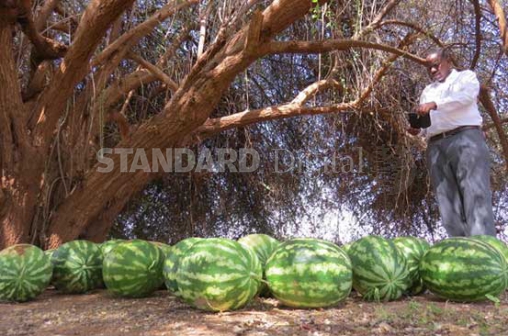
Is there a ‘secret’ to growing water melons? This is the question one reader asked me recently. The answer is yes. Start with the right variety specific to your growing area.
Watermelons come in different varieties. If you want large watermelons, choose a variety that is bred to produce large fruit size, such as Crimson Sweet.
Small-sized water melon varieties are meant to save space in a little garden. If your target is large water melons, avoid those that are described as ‘baby’.
Watermelon plants may grow more slowly if you plant them in the wrong soil. Heavy soils are the worst for growing watermelons because it slows down the germination and in some cases the resulting plants produces flavourless melons.
The best soil for rapid growth and flavourful fruit is sandy loam. Adding organic matter to this soil before planting can achieve good results.
Get the spacing right
Watermelons do take up quite a bit of space with their long vines. A planting space at least 4 feet-by-6 feet gives larger watermelon varieties. The planting location needs full sunlight with a soil pH between 6.0 and 6.8.
Nutrient-rich soil that drains well gives the watermelons an ideal environment that allows them to grow to their full size. To successfully grow watermelons, start them off in a mix of compost, manure and soil.
Side dress the watermelon plants with the recommended fertiliser. The fertiliser encourages growth.
Without proper care throughout the growing season, your watermelons are likely to grow slowly or become damaged by pests or disease. Lookout for signs of pests, including aphids, spider mites, cucumber beetles and squash bugs.
Remove damaged leaves, pick off the insects and spray an insecticidal soap as needed to control the pests.
Fusarium wilt and bacterial wilt are two prevalent watermelon diseases. The best ways to avoid these diseases, which are typically not curable, is to look for disease resistant varieties.
Practice drip irrigation
Stay informed. Subscribe to our newsletter
To maximise the size of the melons, regular deep watering is important especially during the first three to four weeks after planting. Drip irrigation is the most appropriate way to give watermelons a steady supply of moisture.
And in some growing areas, watering the roots directly rather than soaking the leaves, too, helps prevent many common foliar diseases.
Cut back on the water once the plants have begun to set fruit; overwatering dilutes the melon’s sugars and makes the fruit less sweet.
Mulching using straw around the plants keeps the soil moist and minimises contact between the melons and the soil further reducing the risk of diseases. It also obstructs weeds from sprouting.
When to harvest
Harvesting your watermelons too early results in smaller fruit that lacks flavour. Most large watermelon varieties require around 85 to 95 days to reach maturity, so the calendar can help you determine how long to let your watermelons grow. Experienced watermelon growers use a lot of tricks to know exactly when the fruit is ready to eat. Here are a few you can try during this season: When the tiny tendril on the vine just opposite to where the watermelon stem attaches dries out and turns brown, the melon is ripe.
The flat dead sound emitted by a melon when thumped is the real indicator of ripeness, and the one most universally depended on,” “If the resonance is hollow, ringing or musical, it indicates the fruit is immature. The spot where the melon rests on the ground turns greenish-yellow as the melon reaches maturity.
The writer is an expert on sustainable agriculture and agricultural solutions. Reach him on [email protected]
 The Standard Group Plc is a
multi-media organization with investments in media platforms spanning newspaper
print operations, television, radio broadcasting, digital and online services. The
Standard Group is recognized as a leading multi-media house in Kenya with a key
influence in matters of national and international interest.
The Standard Group Plc is a
multi-media organization with investments in media platforms spanning newspaper
print operations, television, radio broadcasting, digital and online services. The
Standard Group is recognized as a leading multi-media house in Kenya with a key
influence in matters of national and international interest.
 The Standard Group Plc is a
multi-media organization with investments in media platforms spanning newspaper
print operations, television, radio broadcasting, digital and online services. The
Standard Group is recognized as a leading multi-media house in Kenya with a key
influence in matters of national and international interest.
The Standard Group Plc is a
multi-media organization with investments in media platforms spanning newspaper
print operations, television, radio broadcasting, digital and online services. The
Standard Group is recognized as a leading multi-media house in Kenya with a key
influence in matters of national and international interest.









